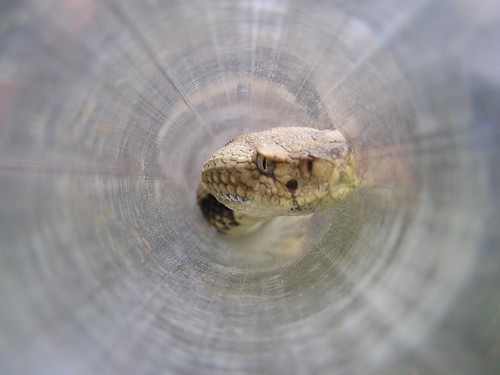
Throughout history, literature and movies, snakes have taken a hit in the public relations department. Think of Cleopatra and the legend of the deadly asp, or the various snakes so feared by a seemingly fearless Indiana Jones in a series of movies by the same name. Then, there is “Snakes on a Plane,” a horrifying look at being stuck on an airplane thousands of feet over the Pacific Ocean as hundreds of deadly and poisonous snakes crawl about.
Not surprisingly, ophidiophobia is rather common. But the fear of snakes in many cases is unwarranted and based on misinformation.
Since 2008, Pennsylvania’s Allegheny National Forest has worked to make certain that the timber rattlesnake habitat on lands managed by the agency is protected. The forest-dependent timber rattlesnake has gone through extensive population declines in some states largely because their habitats have been altered by development. Snakes are an important part of a healthy ecosystem, and can even play an important role in the health and well-being of humans.
For example, new research by a team of University of Maryland biologists shows that the timber rattlesnake (Crotalus horridus) indirectly benefits humankind by keeping Lyme disease in check. Lyme disease is spread to humans by black-legged ticks that feed on infected mice and other small animals. The timber rattlesnake is a natural predator to those small animals.
A former University of Maryland graduate student, Edward Kabay, used published studies of timber rattlesnake diets at four Eastern forest sites to estimate the number of small mammals the snakes consume. He then matched that with information on available number of ticks each small mammal carried. The results showed that each timber rattlesnake removed 2,500-4,500 ticks from each site annually.
Keeping the rodent population in check naturally also helps to prevent crop damage and the spread of other diseases. And, as is the case in nature’s circle of life, rattlesnakes are also important prey for raptors and other animals.
In the northeastern U.S., timber rattlesnakes are considered vulnerable as their population is threatened by habitat loss, road kills and illegal capture. Timber rattlesnakes are a secretive, nonaggressive species. Their primary defense is to lie motionless on the forest floor, relying on camouflage to hide them from predators. The majority of bites occur when someone tries to kill, capture, or harass a snake.
On the Allegheny, forest biologists implanted transmitters into captured snakes in order to locate them and protect undocumented den sites. The goal is to sustain populations of timber rattlesnakes by maintaining and preserving dens. In the past six years, 35 snakes have been implanted and biologists have located 21 new dens.
Maintenance that has taken place to protect habitat includes reducing encroaching vegetation that would eventually create an over story canopy.
Last field season, five snakes were tracked, leading to the discovery of three previously undocumented den sites. The forest hopes to continue the tracking throughout the next couple of years.



